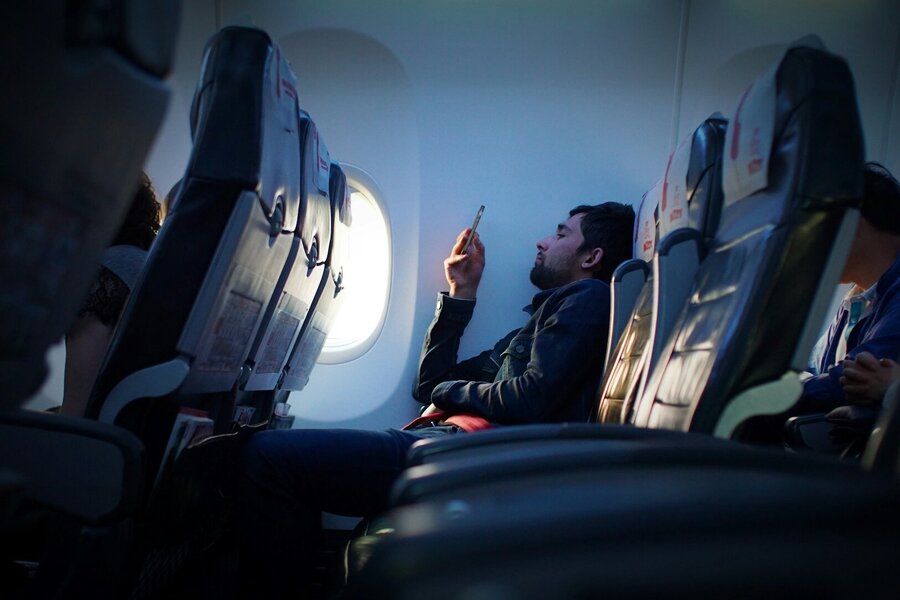Nowadays, travelers really want to have access to Wi-Fi while in the air. Being online has become such an important part of our daily lives that most of us don't want to be disconnected, even during a flight. Many passengers are happy to pay for in-flight Wi-Fi, but often the connection speeds are frustratingly slow. So, what's causing this issue? Why is the Wi-Fi on planes usually so poor? And do some airlines offer better Wi-Fi services than others? You can find all the answers below… Let's get to it!
Flying with Wi-Fi: what to expect?

Source: Javier Cañada/Unsplash
More and more people want Wi-Fi on flights
Due to the increasing use of smartphones, airlines have seen a significant growth in the demand for Wi-Fi over the past decade. Instead of just a few business travelers checking their emails, airlines now have to deal with a much larger number of passengers who expect to have online access for a wide range of activities during their flights.
According to a survey conducted by the in-flight Wi-Fi provider ViaSat in 2023, having connectivity during a flight is now seen as a necessity rather than just a preference, with 83% of the respondents saying they would rebook with an airline that offers better Wi-Fi. The survey also found that free in-flight Wi-Fi is now the second most important factor in influencing booking decisions, surpassing even factors like legroom and in-flight catering, and only coming after the cost of the ticket.
Issues with getting online up in the air
Providing in-flight Wi-Fi is a costly endeavor, mainly due to the challenges of being at high altitudes and traveling at very fast speeds. There are 2 primary methods used to deliver Wi-Fi to passengers on planes.
The first method is the air-to-ground system where antennas under the plane receive a signal from ground-based towers and then transmit it to the onboard server. This type of system, used by Gogo, offers complete coverage across the contiguous United States. The advantage of air-to-ground is the low latency or the short time it takes for the signal to travel. However, the bandwidth is quite limited, typically around 5 megabits per second, compared to 30 megabits per second for mobile broadband. With multiple passengers trying to use the limited bandwidth, the connection quality and speed can be significantly affected.
The second method is the satellite system, which is more expensive than air-to-ground but can handle much more data, resulting in faster speeds for users. Although the coverage area is larger, the number of satellites can still limit the available bandwidth. Traditionally, satellite systems have had higher latency, as the plane's antenna needs to constantly adjust its position to maintain contact with the satellite station, which is over 22,000 miles away. However, the introduction of Starlink's high-speed, low-latency satellite Internet is expected to further improve the quality of in-flight Wi-Fi.
How does the Wi-Fi on the US airlines stack up?

Source: Mohammed Fazil/Unsplash
Passengers have had to deal with slow Internet speeds while flying for a long time. But things are looking better now, as US airlines are investing millions to improve their services. ViaSat has been providing JetBlue's FlyFi service for over a decade, and the best part is that it's free for all customers. However, the quality of the service can vary across different routes. The service works best within the contiguous United States, while the "extended coverage" over the Caribbean, Central America, and the Atlantic is only available on certain types of planes.
Delta, on the other hand, has reportedly spent $1 billion to launch Delta Sync, a program to bring fast and free Wi-Fi to all its passengers, thanks to a partnership with T-Mobile. The rollout is well underway, and Delta hopes to achieve 90% connectivity (based on total available seat miles) by the end of 2024. Southwest Airlines has also recently upgraded its entire fleet with the latest hardware, promising speeds up to 10 times faster than before, for a flat fee of $8 per flight. Alaska Airlines offers satellite Wi-Fi that's fast enough to stream entertainment on most flights for $8.
United Airlines has some flights with faster Internet speeds, but they still use different providers depending on the aircraft and some of these providers are slower. American Airlines also has high-speed satellite Wi-Fi on most of their routes, but some planes still have the older system as of mid-2024.
In February 2024, Hawaiian Airlines announced that they are the first major airline to use Starlink's high-speed Internet service. This system will be installed on their Airbus A321neo aircraft and will be free for all passengers. As airlines try to keep up with the demand and expectations of their customers, the future of in-flight Wi-Fi looks very promising.
The secret to a smooth takeoff: book affordable parking with ParkingNearAirports.io!
Airlines are investing heavily in improving in-flight Wi-Fi, but the journey starts at the airport. Our smart booking platform, ParkingNearAirports.io, simplifies your travel experience by helping you find affordable airport parking rates and convenient locations, including parking lots near DIA or SJC Airport long-term parking. Just focus on enjoying your flight while our service handles the parking!






